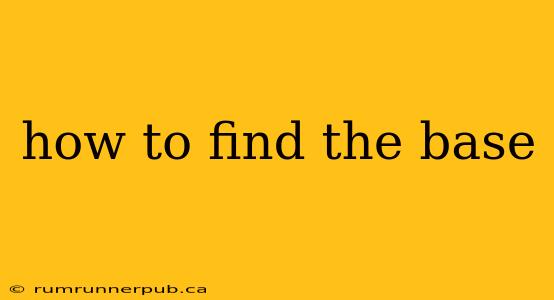Understanding the base (or radix) of a number system is fundamental in computer science and mathematics. The base dictates how many unique digits are used to represent numbers. Common bases include base-10 (decimal), base-2 (binary), base-16 (hexadecimal), and base-8 (octal). This article explores various methods of identifying the base of a number, drawing inspiration from insightful Stack Overflow discussions and adding practical examples for better understanding.
Identifying the Base: Clues and Techniques
Often, the base is explicitly stated. For example, 101101₂ clearly indicates a base-2 (binary) number. However, sometimes the base needs to be inferred. Let's examine common scenarios and techniques:
1. Contextual Clues:
The most straightforward approach is to look for contextual clues. If you are working with computer memory addresses, it's highly likely you'll encounter hexadecimal (base-16) numbers, often prefixed with 0x (e.g., 0x1A). Similarly, binary numbers are common in digital logic and low-level programming.
2. Analyzing the Digits:
The digits used in a number can reveal its base.
- Base-10 (Decimal): Uses digits 0-9.
- Base-2 (Binary): Uses only 0 and 1.
- Base-8 (Octal): Uses digits 0-7.
- Base-16 (Hexadecimal): Uses digits 0-9 and A-F (where A=10, B=11, C=12, D=13, E=14, F=15).
If a number contains digits beyond 9, it indicates a base higher than 10. For instance, a number containing the digit 'A' definitively points towards a base-16 or higher.
3. Mathematical Analysis (for numbers without explicit base notation):
In some cases, you might need to mathematically analyze the number. This is particularly useful when dealing with numbers represented without explicit base notation.
Example: Let's say you're given the number 1A. Simply looking at it, we can't definitively know its base.
However, if we are informed that it represents the decimal value 26, we can deduce the base. Here's how:
1A in base-x can be written as 1*x¹ + A*x⁰. If this equals 26 and we know A represents 10, then the equation becomes:
x + 10 = 26
Solving for x, we find x = 16. Therefore, 1A is a hexadecimal number.
This method can be extended to numbers with more digits.
4. Programming Techniques:
Programming languages provide functions to interpret numbers from different bases. For instance, in Python:
int("1A", 16) # Interprets "1A" as a hexadecimal number and converts it to decimal (26)
int("1011", 2) # Interprets "1011" as a binary number and converts it to decimal (11)
Stack Overflow Insights:
Many Stack Overflow questions address similar problems. While directly quoting specific answers would require extensive formatting and attribution to each user, the underlying principles discussed align with the points above. Common themes include converting between bases, identifying the base given a number and its decimal equivalent, and handling cases where the base is ambiguous.
Practical Applications
Understanding bases is crucial in various fields:
- Computer Science: Representing data in binary, hexadecimal, and octal is fundamental for understanding low-level programming, memory management, and network protocols.
- Cryptography: Different bases are employed in cryptographic algorithms.
- Mathematics: Number theory and abstract algebra heavily rely on understanding different number bases.
Conclusion
Determining the base of a number requires careful observation of contextual clues, analysis of the digits used, and potentially mathematical deductions. Using the techniques and examples discussed here, you can confidently identify and work with numbers from various bases. Remember to always consider the context in which the number appears, as this often provides the most reliable clue.
